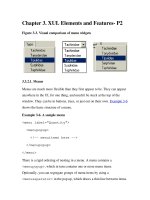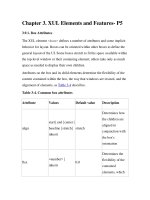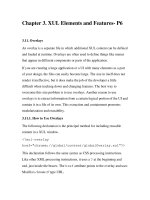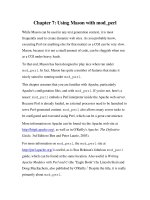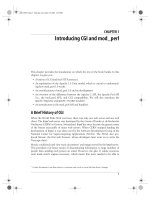Chapter 3 Using Classes and Objects pptx
Bạn đang xem bản rút gọn của tài liệu. Xem và tải ngay bản đầy đủ của tài liệu tại đây (331.19 KB, 38 trang )
Chapter 3
Using Classes and
Objects
© 2004 Pearson Addison-Wesley. All rights reserved 3-2
Using Classes and Objects
•
We can create more interesting programs using
predefined classes and related objects
•
Chapter 3 focuses on:
object creation and object references
the String class and its methods
the Java standard class library
the Random and Math classes
formatting output
enumerated types
wrapper classes
graphical components and containers
labels and images
© 2004 Pearson Addison-Wesley. All rights reserved 3-3
Outline
Creating Objects
The String Class
Packages
Formatting Output
Enumerated Types
Wrapper Classes
Components and Containers
Images
© 2004 Pearson Addison-Wesley. All rights reserved 3-4
Creating Objects
•
A variable holds either a primitive type or a
reference to an object
•
A class name can be used as a type to declare an
object reference variable
String title;
•
No object is created with this declaration
•
An object reference variable holds the address of
an object
•
The object itself must be created separately
© 2004 Pearson Addison-Wesley. All rights reserved 3-5
Creating Objects
•
Generally, we use the new operator to create an
object
title = new String ("Java Software Solutions");
This calls the String constructor, which is
a special method that sets up the object
•
Creating an object is called instantiation
•
An object is an instance of a particular class
© 2004 Pearson Addison-Wesley. All rights reserved 3-6
Invoking Methods
•
We've seen that once an object has been
instantiated, we can use the dot operator to invoke
its methods
count = title.length()
•
A method may return a value, which can be used
in an assignment or expression
•
A method invocation can be thought of as asking
an object to perform a service
© 2004 Pearson Addison-Wesley. All rights reserved 3-7
References
•
Note that a primitive variable contains the value
itself, but an object variable contains the address
of the object
•
An object reference can be thought of as a pointer
to the location of the object
•
Rather than dealing with arbitrary addresses, we
often depict a reference graphically
"Steve Jobs"
name1
num1
38
© 2004 Pearson Addison-Wesley. All rights reserved 3-8
Assignment Revisited
•
The act of assignment takes a copy of a value and
stores it in a variable
•
For primitive types:
num1
38
num2
96
Before:
num2 = num1;
num1
38
num2
38
After:
© 2004 Pearson Addison-Wesley. All rights reserved 3-9
Reference Assignment
•
For object references, assignment copies the
address:
name2 = name1;
name1
name2
Before:
"Steve Jobs"
"Steve Wozniak"
name1
name2
After:
"Steve Jobs"
© 2004 Pearson Addison-Wesley. All rights reserved 3-10
Aliases
•
Two or more references that refer to the same
object are called aliases of each other
•
That creates an interesting situation: one object
can be accessed using multiple reference
variables
•
Aliases can be useful, but should be managed
carefully
•
Changing an object through one reference
changes it for all of its aliases, because there is
really only one object
© 2004 Pearson Addison-Wesley. All rights reserved 3-11
Garbage Collection
•
When an object no longer has any valid references
to it, it can no longer be accessed by the program
•
The object is useless, and therefore is called
garbage
•
Java performs automatic garbage collection
periodically, returning an object's memory to the
system for future use
•
In other languages, the programmer is responsible
for performing garbage collection
© 2004 Pearson Addison-Wesley. All rights reserved 3-12
Outline
Creating Objects
The String Class
Packages
Formatting Output
Enumerated Types
Wrapper Classes
Components and Containers
Images
© 2004 Pearson Addison-Wesley. All rights reserved 3-13
The String Class
•
Because strings are so common, we don't have to
use the new operator to create a String object
title = "Java Software Solutions";
•
This is special syntax that works only for strings
•
Each string literal (enclosed in double quotes)
represents a String object
© 2004 Pearson Addison-Wesley. All rights reserved 3-14
String Methods
•
Once a String object has been created, neither its
value nor its length can be changed
•
Thus we say that an object of the String class is
immutable
•
However, several methods of the String class
return new String objects that are modified
versions of the original
•
See the list of String methods on page 119 and in
Appendix M
© 2004 Pearson Addison-Wesley. All rights reserved 3-15
String Indexes
•
It is occasionally helpful to refer to a particular
character within a string
•
This can be done by specifying the character's
numeric index
•
The indexes begin at zero in each string
•
In the string "Hello", the character 'H' is at index
0 and the 'o' is at index 4
•
See StringMutation.java (page 120)
© 2004 Pearson Addison-Wesley. All rights reserved 3-16
Outline
Creating Objects
The String Class
Packages
Formatting Output
Enumerated Types
Wrapper Classes
Components and Containers
Images
© 2004 Pearson Addison-Wesley. All rights reserved 3-17
Class Libraries
•
A class library is a collection of classes that we
can use when developing programs
•
The Java standard class library is part of any Java
development environment
•
Its classes are not part of the Java language per
se, but we rely on them heavily
•
Various classes we've already used (System ,
Scanner, String) are part of the Java standard
class library
•
Other class libraries can be obtained through third
party vendors, or you can create them yourself
© 2004 Pearson Addison-Wesley. All rights reserved 3-18
Packages
•
The classes of the Java standard class library are
organized into packages
•
Some of the packages in the standard class library
are:
Package
java.lang
java.applet
java.awt
javax.swing
java.net
java.util
javax.xml.parsers
Purpose
General support
Creating applets for the web
Graphics and graphical user interfaces
Additional graphics capabilities
Network communication
Utilities
XML document processing
© 2004 Pearson Addison-Wesley. All rights reserved 3-19
The import Declaration
•
When you want to use a class from a package, you
could use its fully qualified name
java.util.Scanner
•
Or you can import the class, and then use just the
class name
import java.util.Scanner;
•
To import all classes in a particular package, you
can use the * wildcard character
import java.util.*;
© 2004 Pearson Addison-Wesley. All rights reserved 3-20
The import Declaration
•
All classes of the java.lang package are
imported automatically into all programs
•
It's as if all programs contain the following line:
import java.lang.*;
•
That's why we didn't have to import the System or
String classes explicitly in earlier programs
•
The Scanner class, on the other hand, is part of
the java.util package, and therefore must be
imported
© 2004 Pearson Addison-Wesley. All rights reserved 3-21
The Random Class
•
The Random class is part of the java.util
package
•
It provides methods that generate pseudorandom
numbers
•
A Random object performs complicated
calculations based on a seed value to produce a
stream of seemingly random values
•
See RandomNumbers.java (page 126)
© 2004 Pearson Addison-Wesley. All rights reserved 3-22
The Math Class
•
The Math class is part of the java.lang package
•
The Math class contains methods that perform
various mathematical functions
•
These include:
absolute value
square root
exponentiation
trigonometric functions
© 2004 Pearson Addison-Wesley. All rights reserved 3-23
The Math Class
•
The methods of the Math class are static methods
(also called class methods)
•
Static methods can be invoked through the class
name – no object of the Math class is needed
value = Math.cos(90) + Math.sqrt(delta);
•
See Quadratic.java (page 129)
•
We discuss static methods further in Chapter 6
© 2004 Pearson Addison-Wesley. All rights reserved 3-24
Outline
Creating Objects
The String Class
Packages
Formatting Output
Enumerated Types
Wrapper Classes
Components and Containers
Images
© 2004 Pearson Addison-Wesley. All rights reserved 3-25
Formatting Output
•
It is often necessary to format values in certain
ways so that they can be presented properly
•
The Java standard class library contains classes
that provide formatting capabilities
•
The NumberFormat class allows you to format
values as currency or percentages
•
The DecimalFormat class allows you to format
values based on a pattern
•
Both are part of the java.text package

